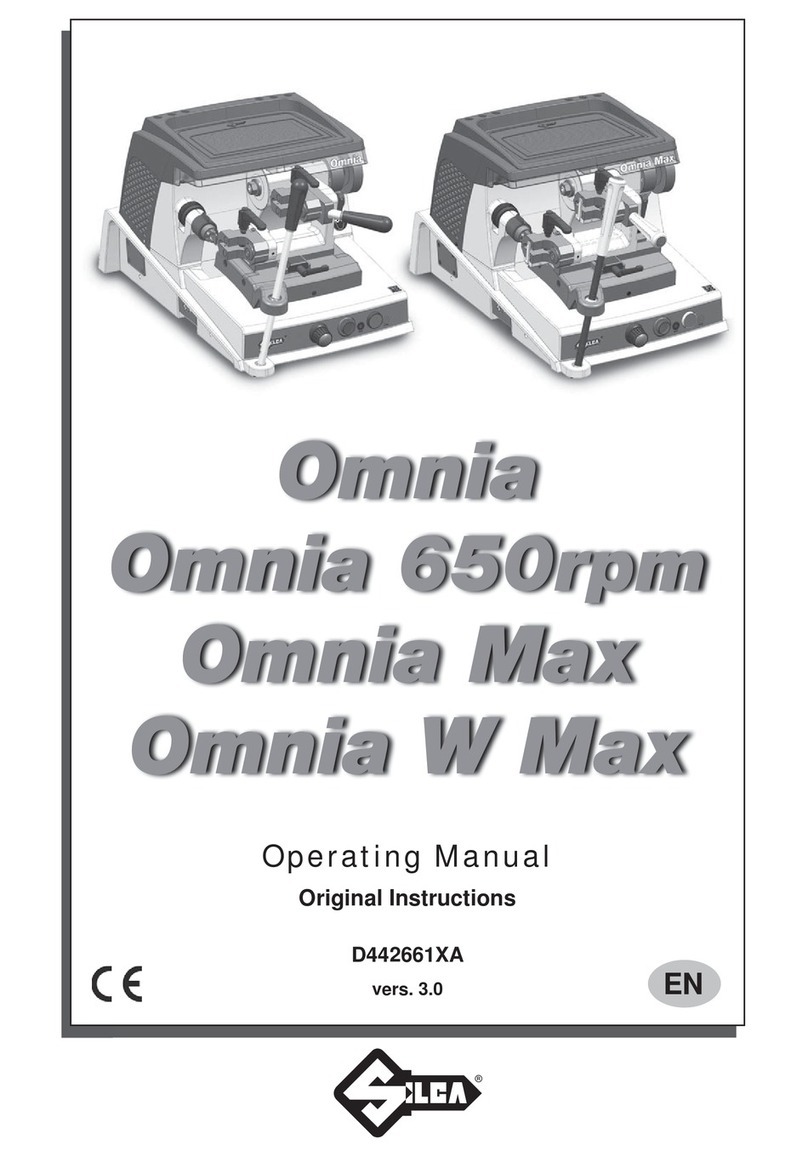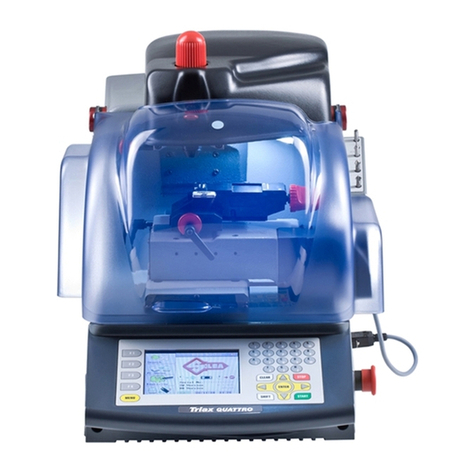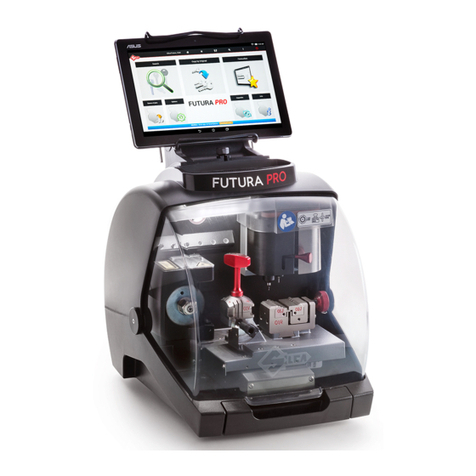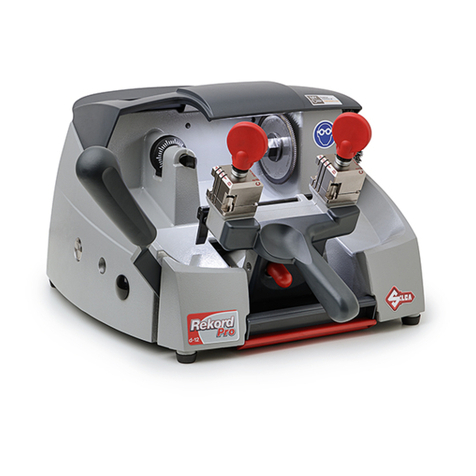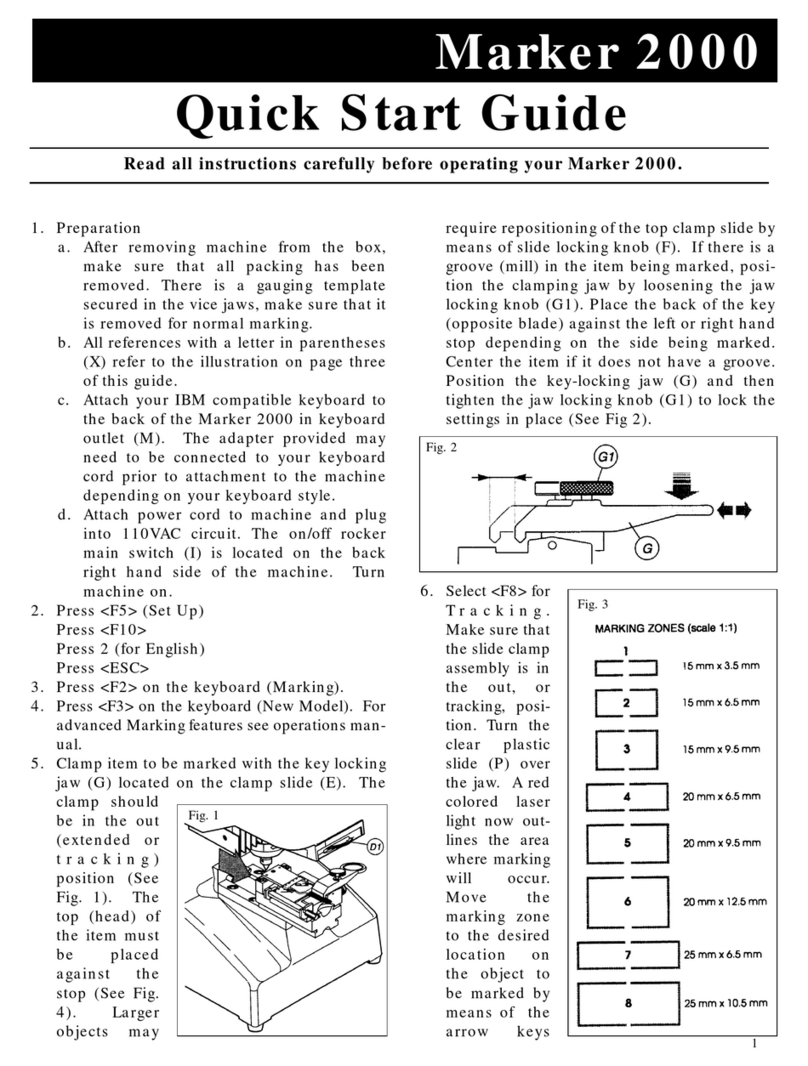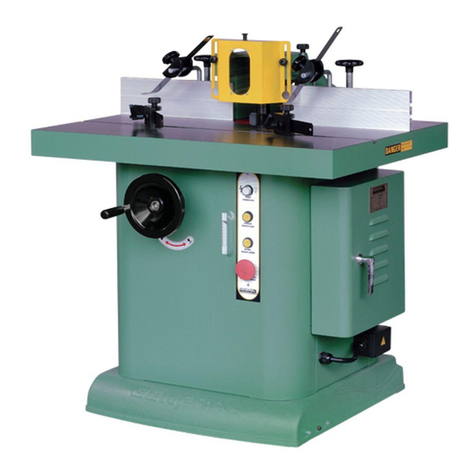Silca MARKER 2000 User manual

®
Operating manual
D430498XA
vers .
4.0

(c) 2002 SILCA S.p.A. - Vittorio Veneto
This manual has been drawn up by
SILCA S.p.A.
All rights reserved. No part of this publication may be reproduced or used in any form or any means
(photocopying, microfilm or other) without the written permission of
SILCA S.p.A.
Published in: September 2002
Printed in
Vittorio Veneto
by SILCA S.p.A.
via Podgora, 20 (Z.I.)
31029 VITTORIO VENETO (TV) - Italy

INDEX
GUIDE TO THE MANUAL ..................................................................................... 1
GENERAL.............................................................................................................. 2
1 MACHINE DESCRIPTION ...................................................................................... 3
1.1 Main Features.............................................................................................. 4
1.2 Working parts .............................................................................................. 5
1.3 Technical data ............................................................................................. 6
1.4 Accessories provided .................................................................................. 6
2 TRANSPORT.......................................................................................................... 7
2.1 Packing........................................................................................................ 7
2.2 Transport ..................................................................................................... 8
2.3 Unpacking.................................................................................................... 8
2.4 Machine handling ........................................................................................ 8
3 MACHINE INSTALLATION and PREPARATION.................................................. 9
3.1 Checking for damage .................................................................................. 9
3.2 Environmental conditions ............................................................................ 9
3.3 Positioning................................................................................................... 9
3.4 Description of work station .......................................................................... 9
3.5 Graphics ...................................................................................................... 9
4 REGULATION and USE of the MACHINE .......................................................... 10
4.1 Clamp ........................................................................................................ 10
4.2 Securing the keys...................................................................................... 11
4.3 Tracking..................................................................................................... 12
4.4 Marking punch regulation ring ................................................................... 13
4.5 Marking...................................................................................................... 13
5 INSTALLATION AND PRELIMINARY OPERATIONS [SET-UP]........................ 14
6 MARKING [F2]...................................................................................................... 15
6.1 New Model [F3] ......................................................................................... 15
6.1.1 Definition of model parameters.............................................................16
6.1.2 String definition [F7] – text entry ...........................................................16
6.1.2-a Attributes definition [F7] ..................................................................17
6.1.2-b Entering fixed strings [F3] ...............................................................18
6.1.2-c Entering the automatic counters [F4]..............................................18
6.1.2-d Entering symbols [F2] .....................................................................18
6.1.2-e Fixed lines (CTRL+F2)....................................................................18
6.1.3 Tracking [F8].........................................................................................18
6.1.4 Save model...........................................................................................19
6.1.5 Marking [F10]........................................................................................20
6.1.5-a Marking by counters........................................................................20
6.1.6 Glass slide customization [F2] ..............................................................21
6.1.7 Clamp configuration [F3].......................................................................21
6.1.8 Counters [F4] ........................................................................................21
6.1.9 Entering a new tracking zone [F5] ........................................................22
6.1.10 Deletion of a tracking area [F6].............................................................22
6.2 Fixed strings [F4]....................................................................................... 23
6.2.1 Deletion of fixed strings [F5] .................................................................23
6.3 List of models [F2] ..................................................................................... 24
6.3.1 Altering the model [F10]........................................................................24
6.3.2 Copy model [F2]....................................................................................24
6.3.3 Delete model [F5].................................................................................25
6.4 SPECIAL FUNCTIONS ............................................................................. 26
6.4.1 Entering fixed strings [F3] .....................................................................26
6.4.2 Entry of automatic counters [F4]...........................................................26
6.4.3 Entering symbols [F2] ...........................................................................27
6.4.4 Fixed lines (CTRL+F2)..........................................................................28

6.4.5 Special characters ................................................................................29
6.5 Data from PC [F3]...................................................................................... 30
6.5.1 Connecting MARKER 2000 to a Personal Computer ...........................30
6.5.2 Transfer of data from Marker 2000 to Personal Computer ...................30
7 SETTING THE ZEROES [F8] ............................................................................... 31
7.1 Regulating the sensors.............................................................................. 31
8 TEST FUNCTIONS ............................................................................................... 33
9 MAINTENANCE.................................................................................................... 35
9.1 Trouble shooting........................................................................................ 35
9.2 Replacing the tracking unit ........................................................................ 36
9.3 Replacing the marking punch.................................................................... 36
9.4 Removing the upper cover ........................................................................ 37
9.5 Replacing the belts and adjusting tension................................................. 38
9.6 Replacing the display ................................................................................ 40
9.7 Checking and replacing fuses ................................................................... 40
9.8 Replacing the control circuit board ............................................................ 42
9.9 Replacing and positioning the sensors...................................................... 42
10 ELECTRICAL DIAGRAMS ................................................................................... 44
11 WASTE DISPOSAL .............................................................................................. 49
12 ASSISTANCE ....................................................................................................... 50
12.1 How to request service.............................................................................. 50

Operating manual - English MARKER 2000
Copyright Silca 2002 1
GUIDE TO THE MANUAL
This manual has been produced to serve as a guide for users of the MARKER 2000 electronic marking
machine. Read it carefully: it is essential if you wish to operate your machine safely and efficiently.
C
ONSULTATION
The contest of the manual are divided into sections relating to:
- Machine description ........................................................................................Chapter 1
- Transport and installation ...............................................................................Chapters 2-3
- Regulation and use .........................................................................................Chapters 4-5-6
- Tests and maintenance ..................................................................................Chapters 7-8-9
T
ECHNICAL TERMS
Common technical terms are used in this manual.
To assist those with little experience of marking keys, below is an illustration of the terms used for the
different parts of keys.
Fig. 1
1) Head
2) Rim
3) Stop
4) Stem
5) Tip
6) Back
7) Cuts
8) Marking
2
1
5
3
6
4
ABCDEF
GHILMN
8ABCDEF
GHILMN
7

MARKER 2000 Operating manual - English
2 Copyright Silca 2002
GENERAL
MARKER 2000 has been designed according to the specifications of the Machine Directives.
From the design stage risks for the operator have been eliminated in all areas: transport, regulation,
marking and maintenance.
Other risks have been eliminated by the use of protective devices for the operator.
The material used in the manufacture of this machine and the components employed during use of the
machine are not dangerous and their use complies with standards.
USE
The electronic marker is designed for the marking of metals in general, brass, silvernickel, etc.
It must be installed and used in the way laid down by the manufacturer.
If the marker is used differently or for purposes different from those described in this manual, the customer
will forego any rights he may have over SILCA S.p.A. Furthermore, unforeseen danger to the operator or
any third parties may arise from incorrect use of the machine.
INCORRECT USE
The marking of plastic materials in general, cardboard, etc. and negligence in the use of the machine or
failure on the part of the operator to observe the instructions given in this manual are not covered by the
guarantee and the manufacturer declines all responsibility in such cases.
It is therefore indispensable to read the operating manual carefully in order to make the best use of the
marker and benefit from its potential.
FURTHER RISKS
There are no further risks arising from the use of the MARKER 2000.
PROTECTION AND SAFETY PRECAUTIONS FOR THE OPERATOR
The MARKER 2000 is built entirely to standards. The operations for which it has been designed are easily
carried out at no risk to the operator.
The adoption of general safety precautions and observation of the instructions provided by the
manufacturer in this manual eliminate all human error, unless deliberate.
The MARKER 2000 is designed with features which make it completely safe in all parts.
• Power supply
MARKER 2000 is supplied with electricity by means of an earthed plug and differential switch.
• Start-up
The machine is started up by means of the master switch on the back.
• Maintenance
The operations to regulate, service, repair and clean the machine have been devised in the simplest and
safest way possible. There in no danger of removable parts being replaced wrongly or unsafely.
• Machine identification
The machine is provided with an identification label which shows the serial number (fig. 2).
Fig. 2
(*) see 11 "WASTE DISPOSAL", page 49.

Operating manual - English MARKER 2000
Copyright Silca 2002 3
1 MACHINE DESCRIPTION
MARKER 2000 is an electronic device designed for marking keys, cylinders and medals using micro-dot
technology. Accurately studied, it adds a high degree of marking precision and elegance to operating
speed and ease of use.
The most complete marking program is obtained by connecting MARKER 2000 to a personal computer
loaded with the “MARKER 2000 PROGRAM”.
Fig. 3
The standard “C1” clamp installed on the machine is used for the cutting of flat keys.
Fig. 4
MARKER 2000
STAND ALONE MARKER 2000
connected to P.C.
“C1”
ABCDEFGHILMNOP
ABCDEFGHILMNOP
ABCDEFGHILMNOP
ABCDEFGHIL
ABCDEFGHIL
ABCDEFGHIL
ABCDEFGHILMNOP
ABCDEFGHILMNOP
ABCDEFGHILMNOP

MARKER 2000 Operating manual - English
4 Copyright Silca 2002
1.1 Main Features
• Movement
Movement of the two axes (x-y) operates on ball couplings which ensure maximum smoothness and fluid
movements, without play.
• “C1” Clamp
Designed to take any type of flat key, it features regulation of the key grip point so that its position is not
altered. In this way flat keys of any length and thickness can be marked.
• Marker punch
A steel punch, simple to replace and with a maximum run on the Z axis of 4 mm.
The punch is moved by means of an electromagnet incorporated in the head of the machine and has a
maximum frequency of 70/80 punches per second.
• Punch regulation ring
With this type of regulation the operator can quickly and easily obtain a suitable marking depth for the type
of character selected and the type of material involved, thereby making full use of the machine’s potential.
•
Tracking
An electronically controlled laser system which, by means of a series of defined areas, allows rapid and
precise identification of the marking zone most suitable for the operator and tracks its position.
The tracking disk installed on the machine includes eight different marking zone.
• Marking
Possible on all models comprised in the range of flat keys, including the creation of a customized file to
memorize texts, marking zones, article numbers, etc.
Keys for centralized locking systems can be marked in mass production.
• Display
Alphanumeric display with scrolling text of 4 lines of 20 characters each, illuminated from behind and
placed in the upper part of the machine.
The technical features and position of the display ensure excellent visibility for the operator.
• Keyboard
The keyboard (standard for IBM* compatible PCs) is an essential part of the machine. It is used both for
writing the texts and for controlling the machine functions through a series of special function keys.
The keyboard is not supplied by the marking machine manufacturer as it is preferable for end-users
to select the most suitable model for their needs from those available on the market (nationality, etc.).
*IBM is a trade mark of the International Business Machine Corporation.
Fig. 5
keyboard
not provided

Operating manual - English MARKER 2000
Copyright Silca 2002 5
1.2 Working parts
Fig. 6
A - marking punch
B - display
C - marking depth regulation ring
D - tracking device
D1 - tracking disk
E - clamp slide
F - slide-locking knob
G - key-locking jaw
G1- jaw-locking knob
H - head unit
I - master switch
L - feeder outlet
M - keyboard outlet
N
- serial port (PC)
O
- clamp sensor
P
- glass slide diffusor
P1
- glass slide rotation knob
B
D
P1
H
C
A
D
1
G1
G
O
E
P
F
N
I
L
M

MARKER 2000 Operating manual - English
6 Copyright Silca 2002
1.3 Technical data
Power:
230V-50Hz - 80 Watt 0.4 Ampere; 110V-60Hz - 90 Watt 0.6 Ampere
Punch:
(tempered) interchangeable, designed for marking keys.
Max. punch frequency:
70-80 punches per second
Movements:
on 2 axes by means of ball couplings
Clamp:
C1 (standard) designed to grip all flat keys
MArker run:
X axis: 50 mm Y axis: 35 mm
Display:
20 characters, 4 lines, illuminated from behind
Keyboard:
standard IBM* compatible with mini din 6 pole socket
Connectors:
standard 9 pin serial port RS232; 25 pin feeder outlet; mini din 6 pole keyboard socket
Dimensions:
width: 220 mm depth: 320 mm height: 450 mm
Mass:
Kg. 20
Noise in use:
Lp (A) = 85.3 dB (A)
1.4 Accessories provided
MARKER 2000 comes with a set of accessories for its operation and maintenance (tools, hex. wrenches,
fuses, etc.) housed in the special tool holder and comprising:
code D112170FA
GLASS SLIDE DIFFUSOR
1 pc.
FUSE (2 pcs)
code D309226ZZ
3.15 Ampere rapid (230V)
code D412279BA
GAUGING TEMPLATE
1 pc.
SET OF HEX WRENCHES
7 pcs.
code D309259ZZ
7 - 8 mm SPANNER
1 pc.
code D312421ZZ
KEYBOARD ADAPTER
1 pc.
FUSE (2 pcs.)
code D308726ZZ
4 Ampere delayed (230V)
FUSE (2 pcs.)
code D312423ZZ
2 Ampere delayed (230V)
FUSE (2 pcs.)
code D309227ZZ
1 Ampere delayed (230V)
Other manuals for MARKER 2000
2
Table of contents
Other Silca Power Tools manuals

